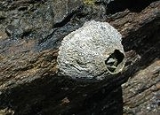
Thecostraca
Encyclopedia
Thecostraca are a subclass
of marine invertebrate
s containing about 1,320 described species. Many species have plankton
ic larvae which become sessile
or parasitic as adults.
The most important subgroup are the barnacle
s (infraclass Cirripedia), constituting about 1,220 known species.
The subgroup Facetotecta
contains a single genus, Hansenocaris, known only from the tiny planktonic nauplii called "y-larvae". These larvae have no known adult form, though it is suspected that they are parasites, and their affinity is uncertain: some researchers believe that they may be larval tantulocarida
ns (no larval tantulocaridans are known, so this would solve two puzzles at once).
The group Ascothoracida
contains about 100 species, all parasites of coelenterates and echinoderm
s.
and in the following classification of thecostracans down to the level of orders:
Subclass Thecostraca Gruvel, 1905
Class (biology)
In biological classification, class is* a taxonomic rank. Other well-known ranks are life, domain, kingdom, phylum, order, family, genus, and species, with class fitting between phylum and order...
of marine invertebrate
Invertebrate
An invertebrate is an animal without a backbone. The group includes 97% of all animal species – all animals except those in the chordate subphylum Vertebrata .Invertebrates form a paraphyletic group...
s containing about 1,320 described species. Many species have plankton
Plankton
Plankton are any drifting organisms that inhabit the pelagic zone of oceans, seas, or bodies of fresh water. That is, plankton are defined by their ecological niche rather than phylogenetic or taxonomic classification...
ic larvae which become sessile
Sessility (zoology)
In zoology, sessility is a characteristic of animals which are not able to move about. They are usually permanently attached to a solid substrate of some kind, such as a part of a plant or dead tree trunk, a rock, or the hull of a ship in the case of barnacles. Corals lay down their own...
or parasitic as adults.
The most important subgroup are the barnacle
Barnacle
A barnacle is a type of arthropod belonging to infraclass Cirripedia in the subphylum Crustacea, and is hence related to crabs and lobsters. Barnacles are exclusively marine, and tend to live in shallow and tidal waters, typically in erosive settings. They are sessile suspension feeders, and have...
s (infraclass Cirripedia), constituting about 1,220 known species.
The subgroup Facetotecta
Facetotecta
Facetotecta is a poorly known infraclass of thecostracan crustaceans. The adult forms have never been recognised, and the group is known only from its larvae, the "y-nauplius" and "y-cyprid" larvae...
contains a single genus, Hansenocaris, known only from the tiny planktonic nauplii called "y-larvae". These larvae have no known adult form, though it is suspected that they are parasites, and their affinity is uncertain: some researchers believe that they may be larval tantulocarida
Tantulocarida
Tantulocarida is a highly specialised group of parasitic crustaceans that consists of about 33 species, treated as a subclass of the class Maxillopoda . They are typically ectoparasites that infest copepods, isopods, tanaids, amphipods and ostracods...
ns (no larval tantulocaridans are known, so this would solve two puzzles at once).
The group Ascothoracida
Ascothoracida
Ascothoracida is a small group of crustaceans, comprising around 100 species. They are found throughout the world, and are parasites on cnidarians and echinoderms....
contains about 100 species, all parasites of coelenterates and echinoderm
Echinoderm
Echinoderms are a phylum of marine animals. Echinoderms are found at every ocean depth, from the intertidal zone to the abyssal zone....
s.
Classification
This article follows Martin and Davis in placing Thecostraca as a subclass of MaxillopodaMaxillopoda
Maxillopoda is a diverse class of crustaceans including barnacles, copepods and a number of related animals. It does not appear to be a monophyletic group, and no single character unites all the members.-Description:...
and in the following classification of thecostracans down to the level of orders:
Subclass Thecostraca Gruvel, 1905
- Infraclass FacetotectaFacetotectaFacetotecta is a poorly known infraclass of thecostracan crustaceans. The adult forms have never been recognised, and the group is known only from its larvae, the "y-nauplius" and "y-cyprid" larvae...
Grygier, 1985 - Infraclass AscothoracidaAscothoracidaAscothoracida is a small group of crustaceans, comprising around 100 species. They are found throughout the world, and are parasites on cnidarians and echinoderms....
Lacaze-Duthiers, 1880-
- Order Laurida Grygier, 1987
- Order Dendrogastrida Grygier, 1987
-
- Infraclass Cirripedia Burmeister, 1834
- Superorder AcrothoracicaAcrothoracicaThe Acrothoracica are a superorder of barnacles.Acrothoracicans bore into calcareous material such as mollusc shells, coral, crinoids or hardgrounds, producing a slit-like hole in the surface known by the trace fossil name Rogerella. They are typically smaller than other types of barnacle, being...
Gruvel, 1905- Order Pygophora Berndt, 1907
- Order Apygophora Berndt, 1907
- Superorder RhizocephalaRhizocephalaRhizocephala are derived barnacles that parasitise decapod crustaceans. Their bauplan is uniquely reduced in an extreme adaptation to their parasitic lifestyle, and makes their relationship to other barnacles unrecognisable in the adult form...
Müller, 1862- Order Kentrogonida Delage, 1884
- Order Akentrogonida Häfele, 1911
- Superorder ThoracicaThoracicaThoracica is a superorder of crustaceans which contains the most familiar species of barnacles found on rocky coasts, such as Semibalanus balanoides and Chthamalus stellatus. They have six well-developed limbs, and may be either stalked or sessile. The carapace is heavily calcified...
DarwinCharles DarwinCharles Robert Darwin FRS was an English naturalist. He established that all species of life have descended over time from common ancestry, and proposed the scientific theory that this branching pattern of evolution resulted from a process that he called natural selection.He published his theory...
, 1854- Order Pedunculata LamarckJean-Baptiste LamarckJean-Baptiste Pierre Antoine de Monet, Chevalier de la Marck , often known simply as Lamarck, was a French naturalist...
, 1818 - Order SessiliaSessiliaSessilia is an order of barnacles, comprising the barnacles without stalks, or acorn barnacles. They form a monophyletic group and are probably derived from stalked barnacles. The order is divided into three suborders. Brachylepadomorpha contains a single family, Neobrachylepadidae, while...
Lamarck, 1818
- Order Pedunculata Lamarck
- Superorder Acrothoracica

